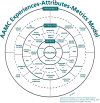Implementation of holistic review into emergency medicine residency application screening to improve recruitment of underrepresented in medicine applicants
- PMID: 34616968
- PMCID: PMC8480502
- DOI: 10.1002/aet2.10662
Implementation of holistic review into emergency medicine residency application screening to improve recruitment of underrepresented in medicine applicants
Abstract
Introduction: Increasing the diversity of the emergency medicine (EM) workforce is imperative, with more diverse teams showing improved patient care and increased innovation. Holistic review, adapted from the Association of American Medical Colleges (AAMC), focuses on screening applicants with a balanced method, valuing their experiences, attributes, and academic metrics equally. A core tenet to holistic review is that diversity is essential to excellence.
Objective: Implementation of holistic review into the residency application screening process is effective at improving exposure to underrepresented in medicine (URiM) applicants.
Methods: After adjustment of our residency application screening rubric, improving our balance across the experience, attributes, and metrics domains, we conducted a retrospective cohort study comparing the representation of URiM applicants invited to interview, interviewed, and ranked by composite score compared to our previous primarily metric-based process.
Results: A total of 8,343 applicants were included in the study. Following implementation of holistic review, we saw an increase in the absolute percent of URiM applicants invited to interview (+11%, 95% confidence interview [CI] = 6.9% to 15.4%, p < 0.01), interviewed (+7.9%, 95% CI = 3.6% to 12.2%, p < 0.01), and represented in the top 75 through top 200 cutpoints based on composite score rank. The mean composite score for URiM applicants increased significantly compared to non-URiM applicants (+9.7, 95% CI = 8.2 to 11.2, p < 0.01 vs. +4.7, 95% CI = 3.5 to 5.9, p < 0.01).
Conclusion: Holistic review can be used as a systematic and equitable tool to increase the exposure and recruitment of URiM applicants in EM training programs.
© 2021 Society for Academic Emergency Medicine.
Conflict of interest statement
The authors have no potential conflicts to disclose.
Figures
References
-
- Diversity in Medicine: Facts and Figures 2019. Association of American Medical Colleges. c2021. Accessed February 26, 2021. https://www.aamc.org/data‐reports/workforce/interactive‐data/figure‐18‐p...
-
- Gomez LE, Bernet P. Diversity improves performance and outcomes. J Natl Med Assoc. 2019;111(4):383‐392. - PubMed
-
- Laveist TA, Nuru‐Jeter A. Is doctor‐patient race concordance associated with greater satisfaction with care? J Health Soc Behav. 2002;43(3):296‐306. - PubMed
-
- Komaromy M, Grumbach K, Drake M, et al. The role of black and Hispanic physicians in providing health care for underserved populations. N Engl J Med. 1996;334(20):1305‐1310. - PubMed
-
- Saha S, Komaromy M, Koepsell TD, Bindman AB. Patient‐physician racial concordance and the perceived quality and use of health care. Arch Intern Med. 1999;159(9):997‐1004. - PubMed
LinkOut - more resources
Full Text Sources


